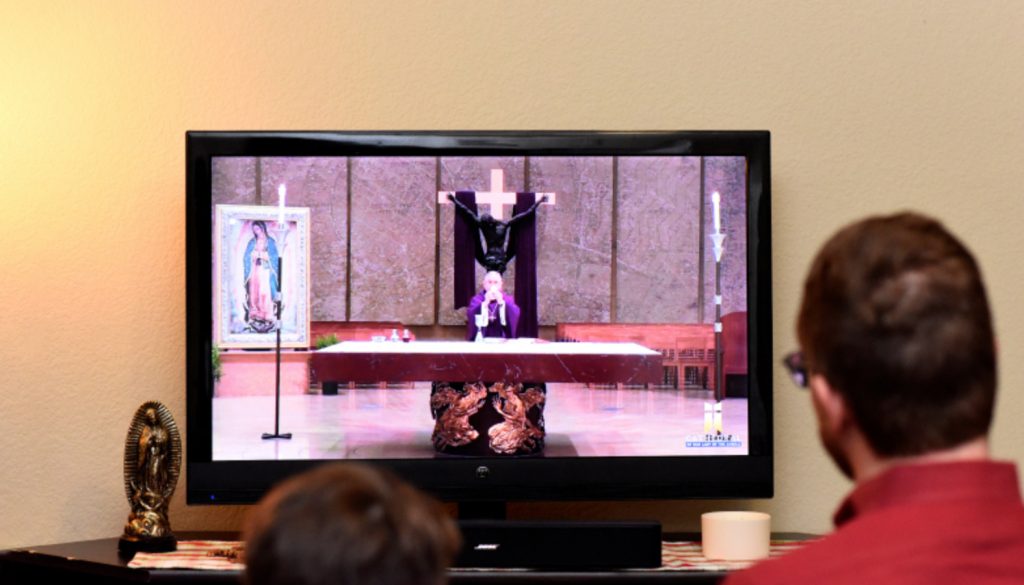The Mass and holy Communion. For most of us, they’ve always been there, and we’ve never had to give them a second thought. If we couldn’t make Mass at our own parish, we could get to another with maybe a slight inconvenience.
Suddenly, then, that was no longer the case. The coronavirus (COVID-19) sent us into quarantine, and the pope and bishops encouraged us to watch Mass on television and offer unfamiliar prayers of “spiritual communion.”
It has been jarring for many Catholics to adjust to these emergency measures. The point of the Mass, after all, is Jesus’ real presence in the sacrament. What remains when the presence is not real, but virtual? Why watch the Mass if we can’t receive the sacrament?
What is the point of a video Mass?
History, even recent history, shows us how much we take for granted.
As recently as 100 years ago, it was common for very few people to receive Communion. At a given Mass, the celebrating priest might be the only communicant.
St. Pope Pius X (1903-1914) had urged the faithful to make frequent Communion, but many people had a lingering sense of their own unworthiness. They went to Mass and prayed. The Church’s requirement was to receive at least once a year, during Easter season.
People in unusual circumstances also had to abstain. For centuries, priests were forbidden to offer Mass on the high seas, especially if the waters were choppy. The danger of spilling the chalice, or scattering the crumbs, was too great. So clergy celebrated a “Nautical Mass,” which eventually became known (strangely enough) as a “Missa Sicca” (“Dry Mass”).
The priest would pray all the prayers of the Mass except the offertory, consecration, and Communion. There was no Communion because there had been no consecration, no sacrifice.
From the last century, there are many stories of priests offering Dry Masses in extreme duress. The Servant of God Walter Ciszek did this in Soviet work camps because he had no regular access to the essential elements: wheat bread and grape wine.
St. Josemaría Escrivá, the founder of Opus Dei, did the same in his confinement during the Spanish Civil War: his altar was a stack of suitcases. There are similar stories from Nazi concentration camps.
The webcast or televised Mass is a very modern way of keeping this very ancient custom.
The U.S. bishops said in their 1996 “Guidelines for televising the liturgy: “Although the televised Mass is not a substitute for participation in the actual celebration of the Church’s liturgy, it does provide an opportunity for those unable to be physically present 1) to identify with a worshiping community, 2) to hear the Word of God, 3) and to be moved to expressions of praise and thanksgiving.”
The Catechism of the Catholic Church even urges us to “make do” in these ways when we cannot attend at the altar.
“If because of lack of a sacred minister or for other grave cause participation in the celebration of the Eucharist is impossible, it is specially recommended that the faithful take part in the Liturgy of the Word … or engage in prayer for an appropriate amount of time personally or in a family” (n. 2183).
Communion is the primary benefit of Mass, but there are many secondary benefits, as the bishops and the Catechism point out, and these are still available in a virtual Mass.
The liturgy is the main bearer of Catholic tradition from generation to generation. By repetition (daily or weekly), it forms us in Catholic culture. We absorb the phrases of the Mass by hearing them regularly. In this way many bits of the Mass have become common coin in the wider culture — “mea culpa” … Lord, have mercy…
The liturgy also keeps us attuned to the uniqueness of each day. We might otherwise forget special feast days, or the memorials of the saints. If we watch the Mass, every day is different in subtle, specific ways. Each day has its own prayers and readings. And the homily can give practical advice for facing our national or local situation as it develops.
The key to remote participation in the Mass is desire. The proven way to stoke that desire is “spiritual communion,” prayers that express the conscious desire to receive Communion when unable to do so physically.
Pope Francis and the bishops have urged the faithful to use such prayers, which the Council of Trent said would bring “very great benefits.” The most common versions are those taught by St. Alphonsus Liguori and St. Josemaría.
A woman on social media movingly compared the televised Mass to Skyping with her husband who is stationed overseas with the military. It’s not optimal, she admitted. In some ways it makes her feel his absence more keenly. But virtual contact is still better than no contact at all, and it renews her longing for the day when her husband returns home.
Every spiritual communion points forward to the next holy Communion. Every virtual Mass helps us anticipate our next actual attendance, on a day God only knows.
Catholic tradition applies the words of the Book of Revelation to the Mass: “For the wedding day of the Lamb has come, his bride has made herself ready” (19:7).
This is one way we make ourselves ready.
Prayers of spiritual communion
At Thy feet, O my Jesus, I prostrate myself and I offer Thee repentance of my contrite heart, which is humbled in its nothingness and in Thy holy presence.
I adore Thee in the Sacrament of Thy love, the ineffable Eucharist. I desire to receive Thee into the poor dwelling that my heart offers Thee.
While waiting for the happiness of sacramental communion, I wish to possess Thee in spirit. Come to me, O my Jesus, since I, for my part, am coming to Thee!
May Thy love embrace my whole being in life and in death. I believe in Thee, I hope in Thee, I love Thee.
Amen.
— Pope Francis (originally attributed to Servant of God Rafael Merry del Val)
“I wish, my Lord, to receive you with the purity, humility, and devotion with which your most holy Mother received you, with the spirit and fervor of the saints.”
— St. Josemaría Escrivá

